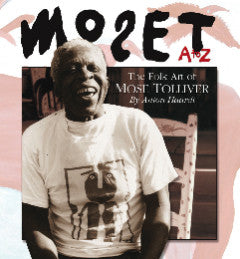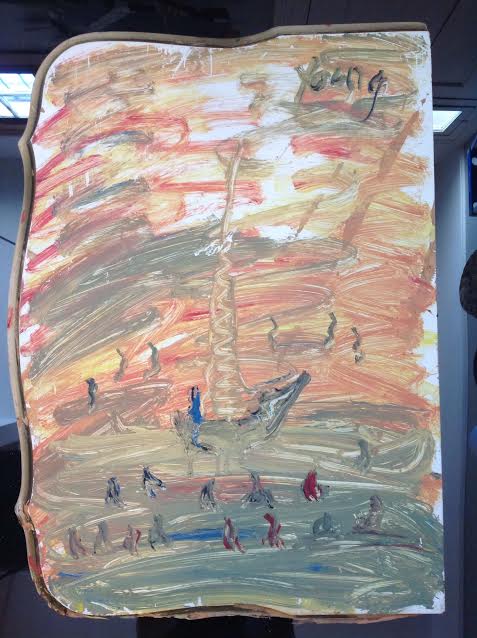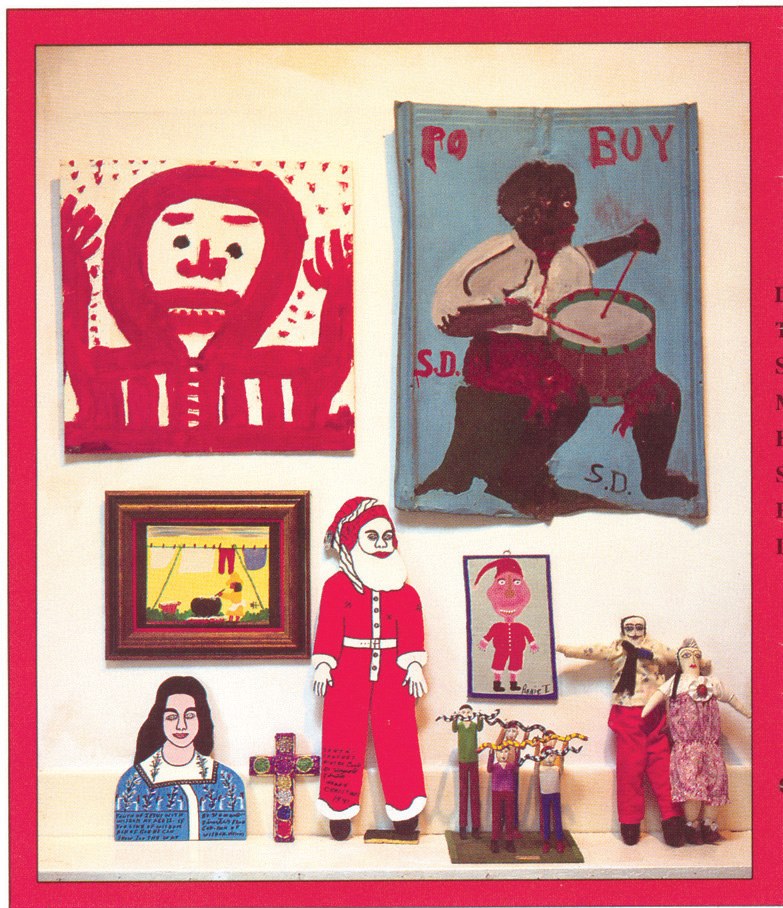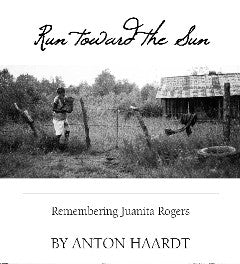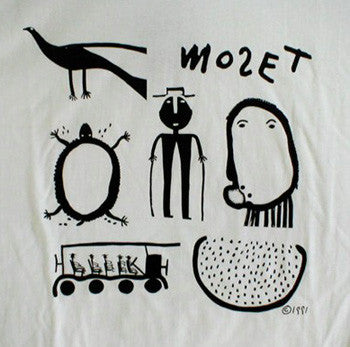News
"Mose T A to Z: Folk Art of Mose Tolliver" By Anton Haardt Book review by Bernadette Geyer
MOSE T A TO Z BOOK REVIEW BY BERNADETTE GEYER
Whether you refer to him as a self-taught artist or a folk artist, Mose Tolliver is a legend and an inspiration. Disabled when a crate of marble fell on his feet and legs, Tolliver turned to art in order to “keep his head together.” But not everyone who practices art therapeutically gains the recognition that Tolliver achieved.
So how did Mose T, as he was known, transform from a gardener/housepainter/ shipping employee into an internationally known and respected folk artist? The answer to this question can be found in Anton Haardt’s book Mose T, A to Z: The Folk Art of Mose Tolliver.
Haardt and Tolliver could not be more different. As the Foreword notes, Haardt was an “accomplished young woman from a socially prominent Alabama family” while Tolliver was a “middle-aged, partially disabled African American painter.” But, they were both artists in Montgomery Alabama. Haardt was drawn to Tolliver’s pictures – with fantastical titles like Jimma Jamma Girl and X-Ray Dry Bones Charlie – which were often displayed in his front yard. Neighbors and artists would often pay him one or two dollars per picture.
In this collection of anecdotes and quotes from Tolliver’s life, alongside an abecedarian compendium of some of his art, Haardt has given the world an opportunity to know Tolliver the way she did. Haardt even includes a timeline of important dates and exhibitions throughout Tolliver’s career.
Mose Tolliver died October 31, 2006. He was in his 80s. Haardt’s book is a must-read for art lovers, as well as for those who think art is only for the wealthy.
Mose T showed us all there is art in doing what you love and loving what you do.
--Bernadette Geyer
Bernadette Geyer is a freelance writer and editor. Geyer is the author of the chapbook WHAT REMAINS (Argonne House Press), and recipient of a Strauss Fellowship from the Arts Council of Fairfax County. She has also written non-fiction for publications such as GoNOMAD, Slow Travel Berlin, and WRITERS' Journal.
Annie May You Rest In Peace

Montgomery Alabama Folk Artist Annie Tolliver died March 13, 2018 after an extended illness.
Annie Tolliver, as a child, used to draw in the dirt yard of Stern Field Alley outside the home where she was born in Montgomery, Alabama. She said that her father, Mose Tolliver, was the first to influence her art. When the family gathered to share a meal they all watched Mose work. Annie started out wanting to paint like her daddy but she said that she later developed a style more her own. Her subjects are her own, with many more details such as tiny white teeth, delicate lace trim on the clothing, and pretty polished fingernails. She painted portraits of her father, her daughters with their bright pink hula hoops, her son gone fishing, or her nieces on a shopping spree. Her brightly colored portraits have a wonderful joy of life.
We have lost one Deep South's great self-taught artists and a good friend.
Annie, may you rest in peace, to the free skies glad and strong.
Art by outsider artist Purvis Young featured on new David Byrne album
“Yellow Abstract - The Journey Home”, painting on found object wooden table top by outsider artist Purvis Young. This painting is predominantly yellow ochres and muted green of an ocean landscape scene with abstract figures. On the back of a the piece, it says: Title ”The Journey Home” purchased direct from the artist. It portrays “spirits bringing a wanderer by ship through a fiery sea to his final home”. I purchased this painting circa 2002 from a dealer in folk art
Purvis Young was born on February 4, 1943 in Liberty City, Miami, FL. Currently Resides: Overtown, Miami, FL. He was first discovered by the art community in 1972 when he painted a series of murals on a row of abandoned buildings called "Good Bread Alley" in the economically depressed section of Miami known as Overtown.
His work is in some ways like a Pollock. Although Purvis was untutored his art has a sophisticated style and at the same time emotional fury, with a look of contemporary sophistication. His doodle-like symbols recall similarly repeated swirls and scribbles found in contemporary expressionist art, as well as in cultural practices found in isolated areas such as art of the Aborigines in Australia.
Purvis Young’s art, which over the years has gained international acclaim, has come into focus recently when David Byrne, on his first album in ten years “American Utopia", featured on its cover Young's art.
Byrne said that he chose Purvis Young’s art because of his "visual meditations are based upon the plight of the underprivileged, racism in America, urban strife and African-American experiences in the South". David Byrne’s worldwide tour promoting his new album takes him to New Orleans Jazz Festival on April 29, 2018.
New Instagram Account
Hello outsider art enthusiasts! Our instagram was hacked, so we've started a new one. Please be sure and follow us!

Offbeat Christmas - Folk Art for yuletide joy
The Anton Haardt Gallery's OFFBEAT CHRISTMAS at 2858 Magazine Street is continuing through the New Year. You'll find the perfect "offbeat" gifts, like a Santa painted by Annie Tolliver, red and green glitter crosses painted by L.W. Crawford, a vintage watermelon painted by Mose Tolliver, or even a folk art t-shirt by Sudduth or B.F. Perkins is available.
Whether it be a miniature ethereal portrait of a yellow-tinted blonde by Sybil Gibson or a faded blue vintage Tolliver Tico Bird, you'll find X-Mas gift treasures on discarded materials such as grocery bags and slate...and all the paintings are direct, powerful, and from the heart.
Folk art gifts are an original and unique yuletide treasure!
Mose T From A to Z: The Folk Art of Mose Tolliver makes a great Christmas gift!
"RUN TOWARD THE SUN: REMEMBERING JUANITA ROGERS" By Anton Haardt
Run Toward The Sun: Remembering Juanita Rogers is a supernatural Photo Memoir of Juanita Rogers, a black self- taught artist from the South . This is a story about a African -American woman and a young privileged white woman -both artists . Behind this double biography is a soulful sub-text that acknowledges the force of friendship, and the fears and strengths that shape and change the lives of not only these two women, but all of us. A story of two bold women, both who chose not to make safe choices. One is rich and one is poor. Both are from the South, and both are artists. They become friends. Through their eclectic friendship, each on their personal quest, they travel through their own rite of passage and gain a better understanding of themselves and each other.-----a story woven with a curious thread...and the devil may care duet of this unusual friendship is true.
I first met Juanita Rogers more than thirty-five years ago, and became a frequent visitor to her home near Montgomery. Over the years I amassed many hours of audio and video-taped interviews with Juanita Rogers and her rural primitive surroundings, and photographed her and many of her creations.
The book is filled with Photographs and quotes from Rogers . The book also contains one essay on Juanita Rogers and her work. Folk art scholar,Tom Paterson, has provided an art-historical appraisal of Juanita's sculptures and paintings.
Hers is a story of an incessant drive for creative expression amidst poverty, social struggle, and tremendous physical disability. Anton Haardt
SUMMARY
Folk artist Juanita Rogers was an uneducated black woman living in a dilapidated shack outside Montgomery, Alabama. She had a powerful creative talent and mystifying spirit. Juanita´s crumbling sculptures were made of mud, moss and bones: frightening evidence of compulsion. The haunting figures were part of Juanita´s stories of magic stones, nuns and graveyard dirt. Much defied logic. I visited her regularly and eventually became her confidant and the mender of her mud creations. I choose not to dismiss her as crazy but instead to explore the mystery of her creative drive. Our challenging climb to friendship continued til her death in 1985.The two of us through our struggles transcended our barriers and together united to preserve and further Juanita's mission. Run Toward the Sun is the celebration of this unique and obstinate artist and my quest to document and elevate her life´s work.
BEGINNING
In the intense heat of summer in Alabama, my life changed abruptly with a ringing telephone. While painting in my studio, a Social worker called seeking my assistance with self-taught artist Juanita Rogers. Juanita , a dark skinned proud woman, lived in a dilapidated shack and was destitute after the recent death of her husband. Her porch was filled with haunting clay sculptures: Ram men and Jungle women that resembled the animal-man masks of the Ivory Coast of Africa. Initially she distrusted my offer of friendship but through regular visits she slowly letting me enters enter her world, view her at work, and document her stories and memories. We formed a pack: I would help her with financial assistance in exchange for drawings.
MIDDLE
I investigated her world and she gingerly unfolded to me her stories of carnival trains nuns her illusory mentor , Stonefish. Her stories tangled my reality, and much of what she said contradicted and defied logic. Mr. Stonefish was an enigmatic character and forever absents. Her sculptures were reminiscent of voodoo but she denied any participation . The chronicles I made of her life was laddened with trails and our friendship was an uphill climb in which often she would not cooperate. I doubted my job with her and its intrusion on my own life. My home had become a mud hospital and my constant errands for Juanita took time away for my own artmakeing. Then in a strange twist one day she pointblank asked me if I was Stonefish...Verifying that she had never really believed her own stories. Feeling somehow that I could be her magic man , Mister Stonefish, and that she had trusted me finally gave me courage to continue.
ENDING
Besides her constant money issues, she had an ongoing health problem that she refused to deal with. She refused medical assistance. Not dealing with her health in a responsible way eventually causes her health to deteriotrate and finally she was unable to live in the rural area unattended. I reluctantly had to commit her to a hospital against her will or I knew she would die. This betrayal further unleashed doubt or questions as to what I should have done .The responsibility was a burden. Shockingly even though she at first threaten to blow of the heads of the doctors she quickly accepted her change and even seemed to enjoy the attention. Sadly the cancer had spread to all her body. As her condition worsened she let me comfort her and be her caregiver. Finally she trusted me. An abrupt end was coming and I sadly was losing my good friend. They lowered her casket into the red clay--the dirt that she so loved.
REFLECTION
Juanita and I shared an equal distrust of others , but in the end our trust for one another `prevailed. Juanita realized I appreciated her and her work. She showed me some of the primal spirit, so often lost today in our modern world.... The rhyme of self freedom Uninterrupted by an overdose of intellect. By breathing life into her sculptures and sharing them with me she symbolically revived herself and me. Juanita affirmed that through the process of creating one can reassemble reality and conquer fears, dreads, and alienation and find strength in ones self. Art can be more than a pretty picture to look at...also art can be nourishing and more important a powerful charm.
By way of comparison, Run Toward the Sun: Remembering Juanita Rogers bears thematic similarities to Los Angeles Times columnist Steve Lopez’ non-fiction book The Soloist, in which Lopez, a relatively privileged Los Angeles journalist, befriends and assists a mentally ill man who lives homeless on the Los Angeles streets but turns out to be a musical prodigy and dropout from New York’s Julliard School of Music. Lopez’ book was recently turned into the popular Hollywood film of the same title, in which his character is played by Robert Downey Jr. and the homeless musician’s character by Jamie Foxx.
"Vision Seekers" By Jason Berry excerpt on Mose Tolliver and Anton Haardt
Excerpt from an Article in New Orlean's Gambit Magazine:
"VISION SEEKERS" By Jason Berry
Anton Haardt felt a magnetic pull to the pink "dinosaur birds" and strange shapings of fruits, animals and human bodies that Mose Tolliver, working on scrap wood, was selling in his yard.
"Mose Tolliver used to hang his paintings in a tree outside his home in Montgomery, Ala., pricing them at one or two dollars a piece," writes Anton Haardt in Mose T. From A to Z: The Folk Art of Mose Tolliver, a forthcoming biography, lushly illustrated, by the woman whose eponymous Magazine Street gallery has perhaps the city's most extensive inventory of high-quality works by black Southern folk artists. The daughter of a wealthy Montgomery real estate agent, Anton Haardt earned a bachelor's degree in fine arts from the San Francisco Art Institute and was starting her own career as a painter in 1969 when she saw Tolliver's paintings outside his house. Tolliver had been crippled several years earlier in an accident on the job at a Montgomery furniture store when a crate of marble fell from a fork lift, crushing his left ankle and destroying the muscles and tendons in his legs. Forced to use a wheelchair and crutches, he threw himself into painting "to keep [my] head together," he said later.
Haardt began buying pictures from Tolliver. "Mose didn't have much in his bank account," she says. He would sell paintings to her for $10 each. She would drive to New Orleans and sell them to Russell Gaspardi, who had a gallery in the Quarter, for $20 each. "Gaspari would sell them for $75 a piece," she says. "I'd give all the money from the sales to Mose, and he would give me two paintings in return."
Tolliver's imagination had a vivid erotic streak in his bulbous female figures, which would hardly have endeared him to Sister Gertrude. He also generated a stream of self-portraits -- a man with walking sticks, and heads that resemble animist masks.
. "Mose and I became very close friends," continues Haardt. "I was also doing a lot of traveling back then. I didn't want him to lose anything on my account." Others, including Gaspardi, began making trips to Montgomery to buy art from Mose T at his home.
The friendship that blossomed between Anton Haardt, a daughter of Alabama's upper crust, and Mose Tolliver, a black man in a wheel chair barely scraping by, typifies the way in which many self-taught painters found their way into the art market. Haardt kept buying and selling his works as an agent on a non-exclusive basis. "I love Mose. I wanted to help him," she says.
In 1982, Haardt arranged for Tolliver to show his works in Washington, D.C., at the prestigious Corcoran Museum of Art's landmark exhibit Black Folk Art in America, 1930-1980.
"Before we left Alabama I had made a bet with Mose that if we bought ten of his paintings to Washington, I could sell them for a lot more money than he could ever imagine," she writes. "I aimed to sell them for one hundred dollars each, a lot of money in 1982, and certainly more than their usual selling price. After the opening, I was accompanied to my hotel room by several prominent folk-art collectors who were interested in buying Mose's paintings. Within minutes I had sold all of Mose's pictures and had one thousand dollars cash in my hand. For me, delivering those earnings to Mose was the pinnacle of our trip."
Over time, as Haardt bought more paintings from Tolliver, she held on to many of them. "I probably have 400 pieces by Mose," she says. She also purchased dozens of works by Jimmy Lee Sudduth, a rural artist whose figurative paintings, using red-brown Alabama mud, radiate a warm lyricism.
The other artist whose work Haardt championed, the late Juanita Rodgers, lived outside of Montgomery in a shack in an open field. For years, Rodgers made sculptures out of mud. Haardt befriended her as well, spending long stretches watching her work and interviewing her about her obsession with mud sculptures. Haardt is completing a book about Rodgers, whose works she has preserved in storage since Rodgers' death.
ANTON HAARDT'S ESSAY on Juanita Rodgers appears in the massive 2000 book Souls Grown Deep: African American Vernacular Art. At $100 a copy, Souls Grown Deep was the brainchild of William Arnett, a pioneering folk art dealer in Atlanta, and his son Paul Arnett. The Arnetts produced a second volume of Souls Grown Deep in 2001 with financial support from Jane Fonda, who settled in Atlanta after her divorce from CNN founder Ted Turner.
Art For Art's Sake
 “Tornado Safe Room” & ”Outsiders in Mexico"
“Tornado Safe Room” & ”Outsiders in Mexico"
Gallery doors swing wide as New Orleans falls for art! It may be the annual defining moment for the visual arts in New Orleans. Galleries throughout the city join forces in one massive art opening known as Art for Art’s Sake. Please join us!
TORNADO SAFE ROOM - ANTON HAARDT
The human response to Tornados and Hurricanes spans a continuum from fascination to terror. Though we recognize the need to protect ourselves from the physical dangers of the great storm, we are yet drawn to witness its awesome power. The”Storm" is a universal symbol of the Self in its most primordial form. Both aboriginal and modern cultures paint a vivid picture of how human-kind has related to this cataclysm of nature, inwardly and outwardly, for millennia.
ANTON HAARDT's storytelling paintings are, in part, based on her encounter with Hurricane Katrina. She was in the eye of it all when she did not evacuate with the thousands of New Orleanians...it was too late and the traffic jams had already halted exit from the Big Easy.
TORNADO SAFE ROOM features a series of painted shadow boxes. These boxes prospose the possibilty that there can be a "tornado safe room" to save one from a pending hurricane. Well maybe not fool proof , but at least a good hope! Her asseblages are complete with red glitter shoes in the center of the box - colaaged with 1950's wall paper of house themes...and other icons including a government stamp of a whirlwind
tornado stating " tornando safe room ". She has "saved' dog lovers, artist, writer, and lesbian couple and more....
The key painting in the show is titled," Hurricane of the Spirit:" created the month before Katrina ravaged Nawlins is the story of a dog and cat (like the Gingham and Calico ones ) struggling through deep foreboding waters...till a cat at the top seems to rise to the heavens encompasses by dark menacing thunderclouds. The painting in rich blues and greens with the deep troubled skies point to a pending storm.
OUTSIDERS IN MEXICO
For over twenty years, Anton Haardt has made her summer residence in Yelapa,Mexico, a pristine fishing village overlooking the sparkling Pacific. Her travels through Mexico have afforded her the opportunity to amass a singular collection of Mexican folk art. The vibrant and colorful art she has brought back is matched by its equally colorful histories in small villages,where faith and devotion are an everyday part of life. On Exhibit are "Ex- votos *, illustrated offerings to saints usually painted on metal. Their bright, detailed pictures celebrate miraculous events in the lives of those who commissioned their painting. Traveling through ageless towns like San Miguel and Guanajuato, one can still see Ex Votos and Retablos decorating the walls of some of the oldest churches in the Americas.
There will be a collection of Glittered Sculpture Cartoneria¹s, commonly called Day of The Dead dolls. These are modern recreations inspired by the character etchings of skeletons popularized in the 1850s. Anton befriended an old woman in Puerta Vallarta who makes elegant glittered paper mache Sculptures. Her creations range from Flamenco dancers to shrouded Skelton Brides, each one with its own wit and elegance. Ms Haardt has also found contemporary artists such as David Mecalco, who has produced a body of work as original and striking as any american folk art counterparts.The rolling paths and lush jungles of Mexico have inspired Anton's own art, creating a unique mix of familiar and fantastic, tropical and urban.Ms. Haardt has recently returned from Mexico, and is pleased to offer her latest acquisitions from Mexico, along with her best pieces from twenty years of traveling and collecting Outsider Art Inside Mexico .
Excerpt from "Alabama Picasso" By Ben La Roco
Published in Brooklyn Rail a publication for arts, culture, and politics throughout New York City and beyond
" In The Anton Haardt Gallery, there were paintings everywhere.There must have been at least another 40 Tollivers in the gallery. There were flower drawings by Sybil Gibson and weird dancing drawings by Thornton Dial. There were paintings by Mose’s daughter, Annie Tolliver, that looked kind of like Mose’s only a little more refined. There were Central American retablos paintings and handmade musical instruments. There were stacks of portraits by Jimmy Lee Sudduth, who put sugar in black mud and painted on wood. In the back were sculptures by Juanita Rogers made from mud and bone. I’m not sure sculpture is the right word for Rogers’s work. They look like space aliens that got run over and freeze dried and should have died but sit around lumpily on the floor instead. There was a small colored pencil drawing by Dilmas Hall about a shoe that got caught in a hurricane and dragged halfway across the country and wound up on his front lawn. The walls were covered with art and sculptures. Them was one by ‘Son’ Ford Thomas ,who was a blues guitarist who worked in a graveyard and made sculptures that look like parts of dead people.
‘Son’ Thomas was a part of the generation, now almost gone. These artists mostly didn’t start making art until they were into mid or late life or until they were injured so badly they couldn’t do anything else. Art was a way to survive despite hard times or an expression of a feeling about the world after having been around long enough to have seen part of it. That’s what the blues is about. Blues teaches repetition and variation on very simple rhythms. It’s not the newness of the song, but how you play it that matters. The songs are almost always old. Some blues players wreck the songs intentionally by playing or singing out of key. ‘Son’ House did that. This lessens the mind’s grip on the music and the emotion flows and is freed to enter the world through things instead of through language. I imagine that’s how ‘Son’ Thomas wound up making sculpture from looking at dead people.
Maybe that’s why Mose Tolliver made paintings and hung them in trees in front of his house after his legs were crushed in an accident at work. Maybe Picasso felt the same thing and that’s why he spent so much time unlearning everything he’d learned, leaving behind the things he invented and destroying what he’d made."
